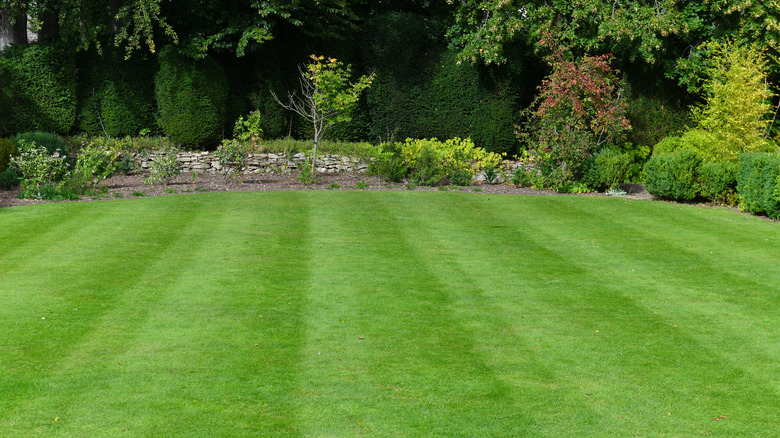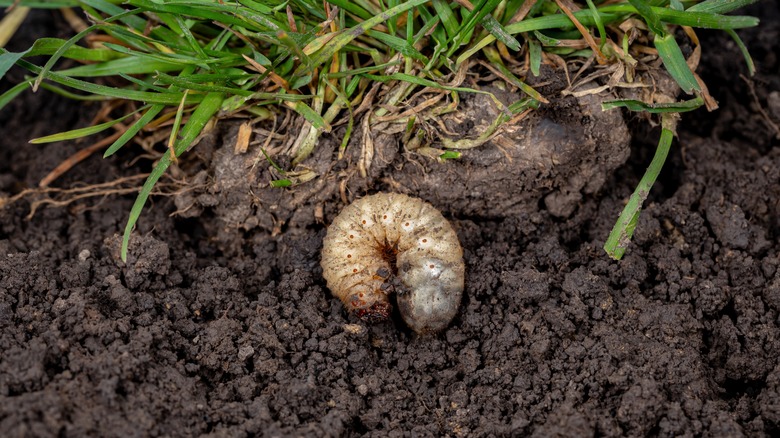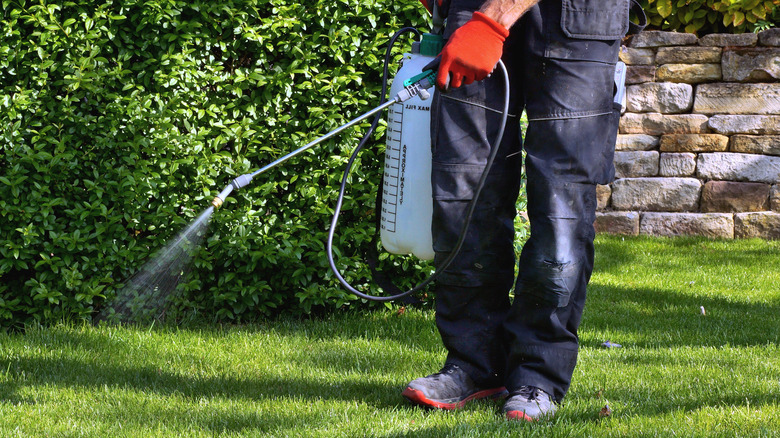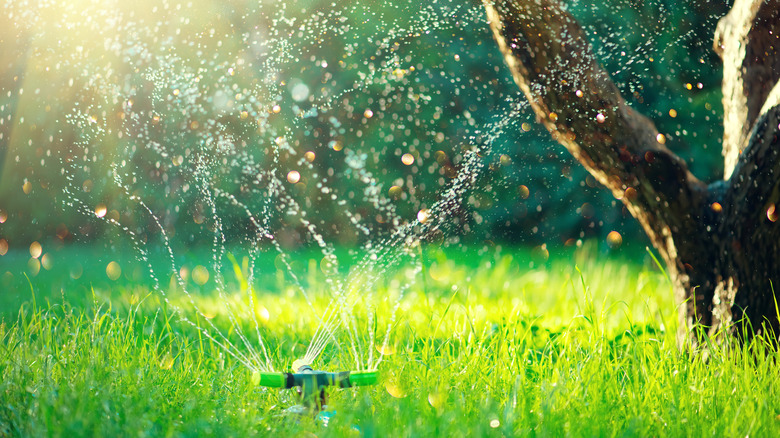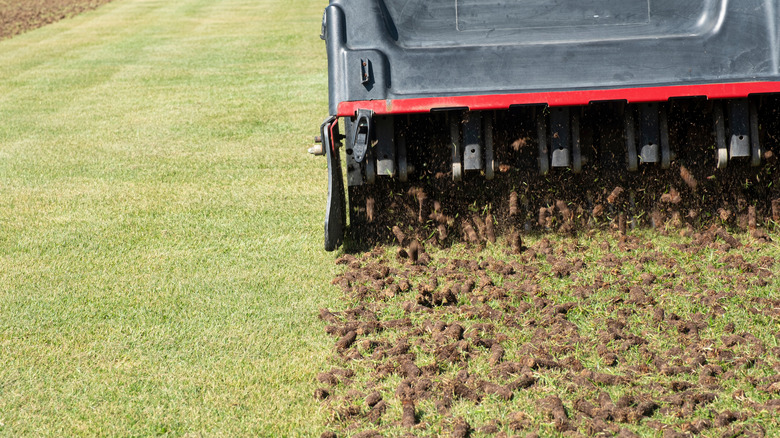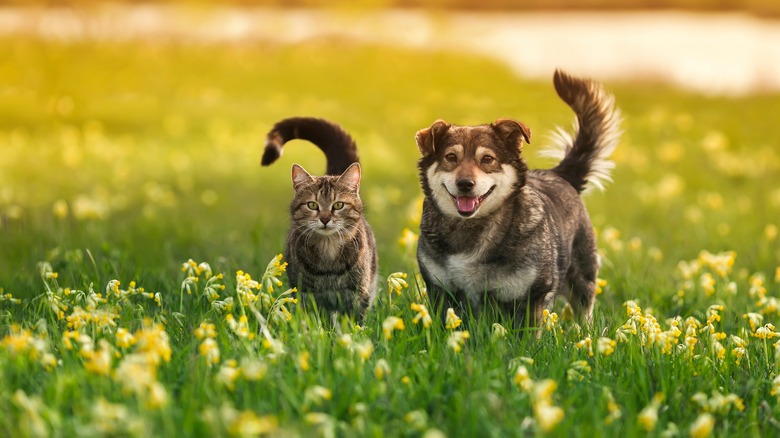Why Perfect Lawns Are Harmful To The Ecosystem
Perfectly trimmed, weed-free lawns date back to the 1600s in Europe as a sign of the owner's status in the community and their wealth. Centuries before the invention of the gas-powered lawnmower, grasses had to be trimmed and weeded by hand, an arduous process that required many groundskeepers. Although many people would argue that these perfect lawns are pretty — and we can all probably agree that they are tidy — many of the practices required to keep a lawn pristine are harmful to the ecosystem.
While it's unlikely any of us are trimming our lawns with a scythe in the 21st century, perfect lawns are still considered a sign of wealth. Instead of employing many people for the task of keeping a lawn tidy, we save time and effort by removing native plants and topsoil in favor of installing cultivated sod, spraying synthetic herbicides to kill unwanted plants, and using gas-powered engines to keep the lawn trimmed. Perhaps we should send perfectly manicured lawns the way of the corset and petticoat and change the current fashion to natural lawns that support rather than damage the environment.
Lawns create an unbalanced ecosystem
Grass lawns are considered a monoculture — an area where only one kind of crop is grown. Monocultures are sometimes referred to as biological deserts because they do not support many species in the ecosystem. For example, a lawn where dandelions are allowed to bloom offers some of the earliest food for bees and other beneficial insects, whereas, grass lawns do not offer anything to support a balanced ecosystem.
Not only does grass not benefit the ecosystem, but sod imported from Japan in the early 1900s brought the Japanese beetle to the United States. While the adults feed on over 300 types of plants, the grubs feed on the roots of turf grass, the same kind of grass that makes a lawn look perfect. Japanese beetles lay their eggs in turf grass, those eggs hatch into grubs, and the grubs grow into adults that ravage vegetable and landscaping plants. For as long as there are large swaths of monoculture grass lawns, the cycle of an unbalanced ecosystem will continue.
Concerns about synthetic lawn chemicals
If you do not have the time to pull every weed in your lawn by hand, you will need to employ the use of synthetic chemicals to treat and prevent weeds (And by weeds, we mean everything that is not grass.) Americans spend around $32 billion annually to keep perfect lawns. Much of the money spent in this industry goes into herbicides, fertilizers, and pesticides.
Perhaps the use of these synthetic chemicals would not seem like much of a problem if they remained in your lawn — but they do not. Rainwater washes these products into waterways, poisoning fish and other wildlife. An increasing problem nationwide is the growth of algae in waterways. Nitrogen flushed away from the overfertilization of lawns contributes to this excess growth of algae, which affects the water quality everywhere from small ponds, to riverways where they are carried all the way to the ocean's coast.
Water and gas usage
When mother nature does not provide enough rain, lawns require a lot of water to stay green. The shallow root systems of turf grass make them especially susceptible to drought conditions. In fact, around 30% of water consumed in the average American home is used outdoors. That adds up to around 9 billion gallons of water daily, just for use in lawns and gardens. This massive usage is a drain on the family budget and the amount of clean water available in some regions. What's worse is that about half the water used for irrigation evaporates or runs off the surface of the soil — which in turn affects the larger ecosystem.
Lawns are also a major contributor to the use of gasoline. Although there are electric lawnmowers available, they do not have the power of a gas engine, so they are not a viable option for lawn care companies or people with large yards. All those mowers, weed eaters, and edgers that make a lawn look perfect consume a lot of fuel. When you are managing your own lawn, it probably does not seem like much, but nationwide, around 800 billion gallons of gas are consumed by lawn maintenance practices.
Benefits of grass
Now that we have thoroughly demonized the use of turf grass, let's talk a little bit about the potential benefits. Grasses have always been a source of food for animals that graze, and hardier varieties have historically been used to make things like baskets and other useful items. Ornamental grasses can be attractive in a landscape. Even lawns have some benefits. Although not as effective as native plants, grass does offer erosion control, as the roots, even if they are relatively shallow, help prevent topsoil from washing away.
Since it is a plant, turf grass converts carbon dioxide into oxygen. Having a grass lawn rather than gravel or cement surrounding your house also reduces heat, keeping your home cooler. Lawns that are sufficiently aerated also help absorb water, preventing stormwater runoff, but this does require maintenance. Over time, grass lawns become compacted and perform more like cement than soil. Still, with proper maintenance, grass can be useful.
Solutions
Perhaps the solution to having the best lawn is to give up the idea that the traditional monoculture lawn is perfect. Natural lawns are becoming more popular as an increasing number of people understand the environmental impacts of perfect lawns. Most homeowners cannot simply let their lawns grow wild — but you can learn to live with some good weeds. Since dandelions and wild violets are some of the earliest sources of food for bees, you can skip the herbicide and let them bloom. Not only does this practice remove herbicides from the environment, but it helps balance the ecosystem by feeding beneficial insects.
Lawns also do not have to be all or nothing. If you are concerned about your curb appeal, keep your front lawn but allow the backyard to be a little more natural. Consider switching from synthetic fertilizers to organic compost to keep your grass healthy, and water in the early morning to reduce evaporation only when absolutely necessary. Even just a few slight changes can make a big difference in creating a more balanced ecosystem.
